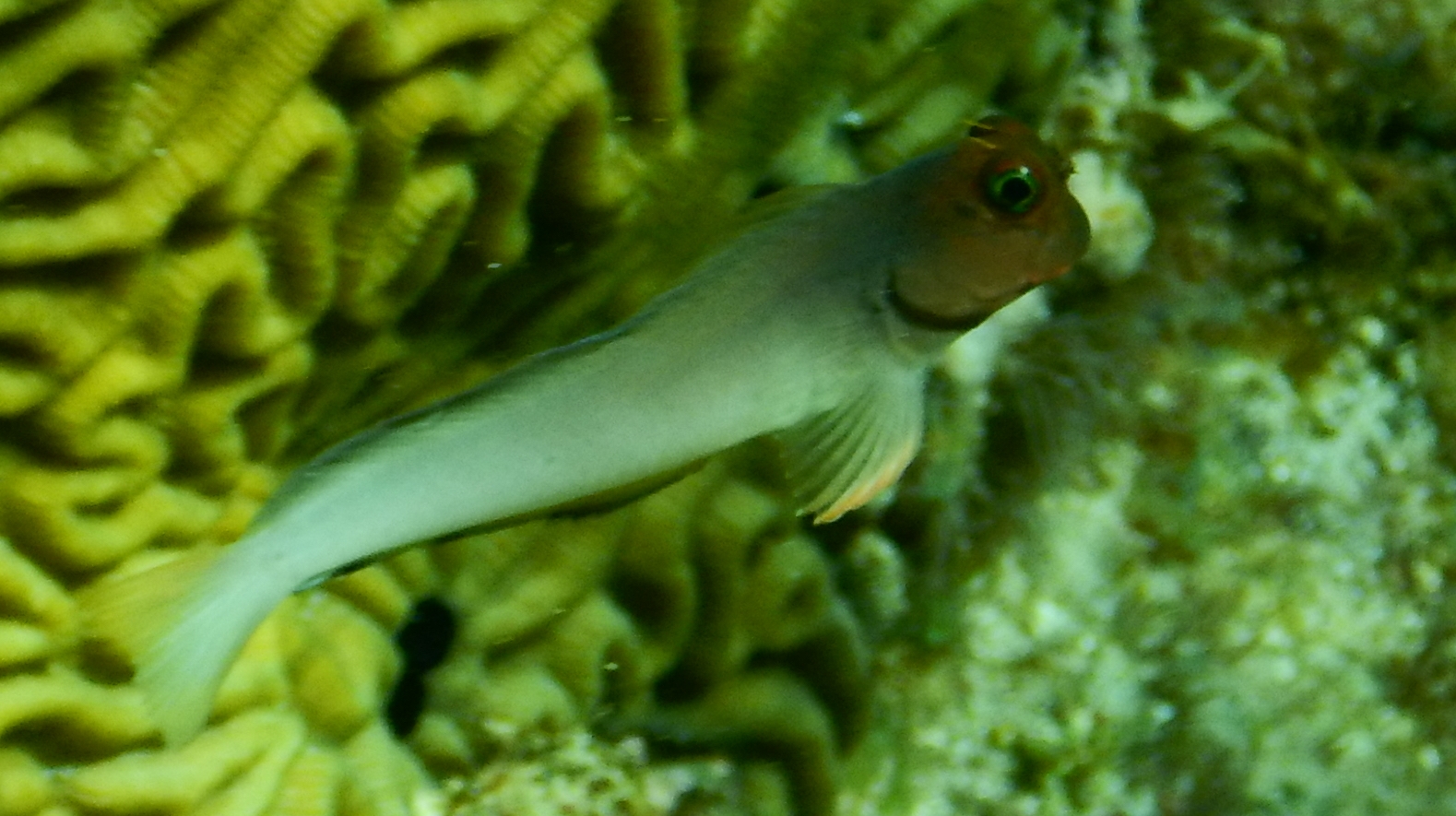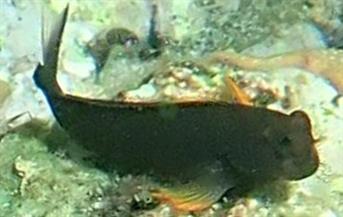



Ophioblennius macclurei
| Ecological Descriptors | ||||
| Habitat | Size (cm) | Diet | Behaviour | Sex |
| Co, R | 12 | Veg, Wor, Cru, Mol |
Ter | F |
Description:
Dark, blunt, reddish brown head. Bicolour variant with a dark head/ reddish head and grey to white body, or solid chocolate brown . Large red lower lip. Part of pectoral fins and margins of dorsal and anal fins may also be red. Single, slender cirrus above each eye, sinlge branched cirrus above each nostril and a pair of short cirri on each side of nape.
Nuptial males display white/ pale bands and blotches on head and lips when guarding eggs.
Ecology
Reef-associated and inhabits shallow, clear waters with coral or rock substrate. Aggressive territorial behavior is performed to defend resources such as food, shelter, possible mates, spawning sites and offspring. This territorial behaviour is directed towards other benthic fishes, as they may take over its shelter and spawning site, but isr is most severe towards conspecifics. Despite severe territoriality, during the periods of lower adult blenny density, many blennies gather up and fight against old residents to take over their territories. After such aggressive competition, each old resident usually ends up with only half of its previous territory.
Consumes filamentous algae and benthic invertebrates.
Life Cycle
Reproduces all year-round in the 10 days before and 4 days after a full moon. Males and females pair in the first 3 hours of daylight and the female enters the male's territory. The male prepares a nest, makeing a "small box-like" space in its territory, removing coral rubble and dead algal crusts from the space.
The male usually has ~5 nests, the time spent at each being determined by how much the nest is favoured by females. Usually the most favored nest has a larger inner surface area and volume than the less favored ones. Affter inspecting the nest, the female choses whether or not to mate. Larger males with larger nests have better chance of successful mating than smaller males with smaller nests. During spawning seasons, males reduce their feeding. The eggs are attached to the substrate via a filamentous, adhesive pad or pedestal.and the male guards and cares for the eggs by blowing air onto them until they hatch as planktonic larvae. The egg batches in one nest may be at different developmental stages because the male redlip blenny is polygynous, mating with multiple females.Female redlip blennies tend to be polyandrous as well, meaning that there are multiple nests with one female's eggs.
Dark, blunt, reddish brown head. Bicolour variant with a dark head/ reddish head and grey to white body, or solid chocolate brown . Large red lower lip. Part of pectoral fins and margins of dorsal and anal fins may also be red. Single, slender cirrus above each eye, sinlge branched cirrus above each nostril and a pair of short cirri on each side of nape.
Nuptial males display white/ pale bands and blotches on head and lips when guarding eggs.
Ecology
Reef-associated and inhabits shallow, clear waters with coral or rock substrate. Aggressive territorial behavior is performed to defend resources such as food, shelter, possible mates, spawning sites and offspring. This territorial behaviour is directed towards other benthic fishes, as they may take over its shelter and spawning site, but isr is most severe towards conspecifics. Despite severe territoriality, during the periods of lower adult blenny density, many blennies gather up and fight against old residents to take over their territories. After such aggressive competition, each old resident usually ends up with only half of its previous territory.
Consumes filamentous algae and benthic invertebrates.
Life Cycle
Reproduces all year-round in the 10 days before and 4 days after a full moon. Males and females pair in the first 3 hours of daylight and the female enters the male's territory. The male prepares a nest, makeing a "small box-like" space in its territory, removing coral rubble and dead algal crusts from the space.
The male usually has ~5 nests, the time spent at each being determined by how much the nest is favoured by females. Usually the most favored nest has a larger inner surface area and volume than the less favored ones. Affter inspecting the nest, the female choses whether or not to mate. Larger males with larger nests have better chance of successful mating than smaller males with smaller nests. During spawning seasons, males reduce their feeding. The eggs are attached to the substrate via a filamentous, adhesive pad or pedestal.and the male guards and cares for the eggs by blowing air onto them until they hatch as planktonic larvae. The egg batches in one nest may be at different developmental stages because the male redlip blenny is polygynous, mating with multiple females.Female redlip blennies tend to be polyandrous as well, meaning that there are multiple nests with one female's eggs.
Redlip Blenny




134
133
132

Redlip Blenny
Redlip Blenny





Redlip Blenny
581

